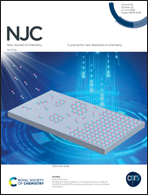A facile “off–on” pattern based on one-pot synthesis of N-doped carbon dots for sensitive detection of Ag+ and S2O32−†
Abstract
In this work, a new “off–on” fluorescence strategy for the determination of Ag+ and S2O32− is presented. Nitrogen-doped carbon dots (N-CDs) were synthesized using oxalic acid dihydrate and anhydrous ethylenediamine via a one-pot hydrothermal treatment without further chemical modification. The surface structure and optical properties of the synthesized N-CDs were characterized. The N-CDs emitted bright blue fluorescence with a high quantum yield of 26.01%. Ag+ could selectively quench the fluorescence of N-CDs due to the formation of a N-CDs-Ag+ complex on the surface. The quenching effect demonstrated a linear relationship in the range of 0–14 and 14–80 μM with a low detection limit (LOD) of 150 nM. Furthermore, S2O32− could combine with Ag+ to generate a more stable Ag+–S2O32− complex, and thus the fluorescence of the N-CDs-Ag+ system could be restored by adding S2O32−. The N-CDs-Ag+ solution behaved as a secondary fluorescent probe to detect S2O32− in the range of 0–50 nM with an extremely low LOD of 1.5 nM. The N-CDs were successfully applied to analyze Ag+ and S2O32− in real samples with satisfactory recoveries (99.04–103.20% and 97.11–99.84%, respectively), implying good applicability in practical analysis.



 Please wait while we load your content...
Please wait while we load your content...